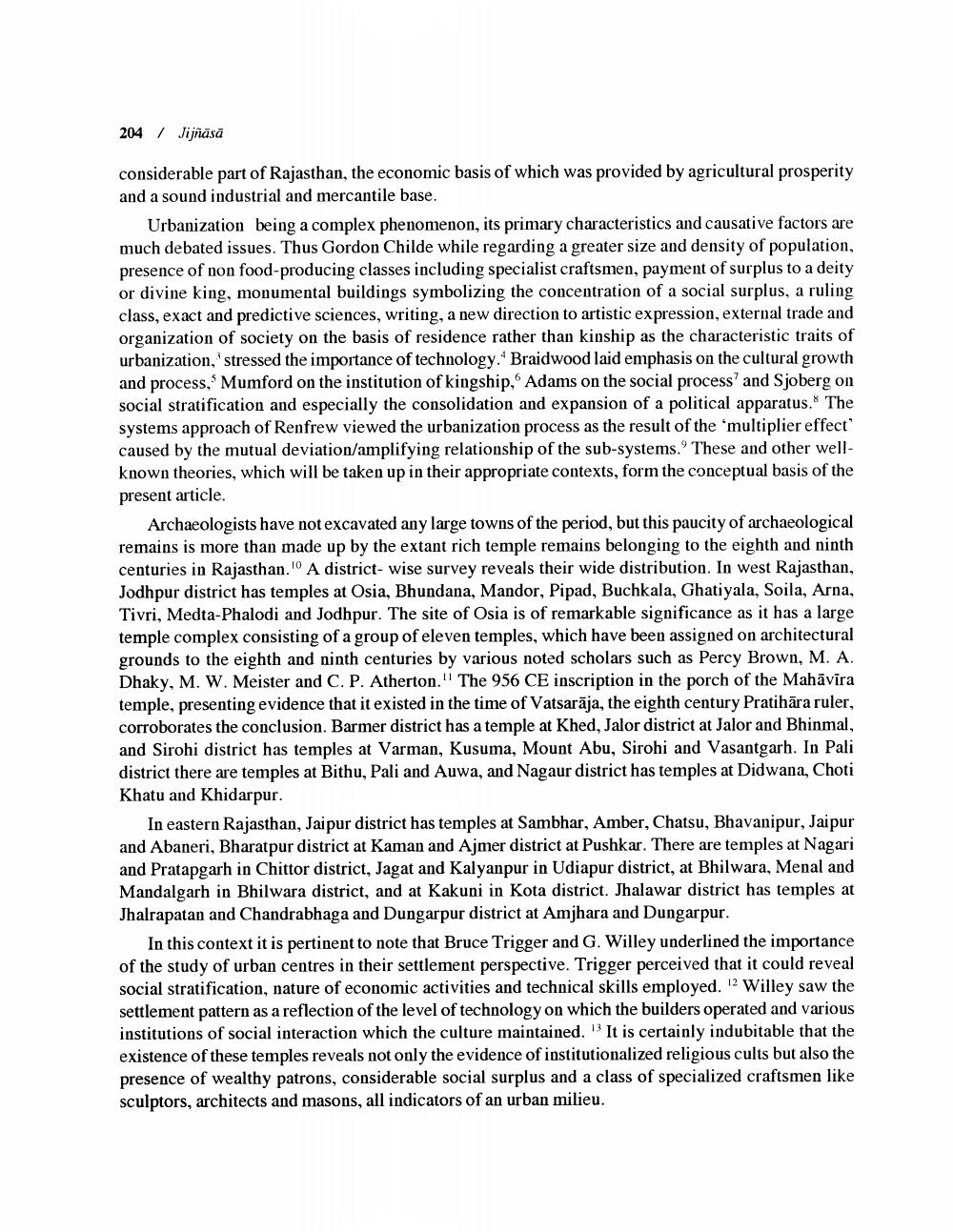________________
204 /
Jijñāsā
considerable part of Rajasthan, the economic basis of which was provided by agricultural prosperity and a sound industrial and mercantile base.
Urbanization being a complex phenomenon, its primary characteristics and causative factors are much debated issues. Thus Gordon Childe while regarding a greater size and density of population, presence of non food-producing classes including specialist craftsmen, payment of surplus to a deity or divine king, monumental buildings symbolizing the concentration of a social surplus, a ruling class, exact and predictive sciences, writing, a new direction to artistic expression, external trade and organization of society on the basis of residence rather than kinship as the characteristic traits of urbanization, stressed the importance of technology. Braidwood laid emphasis on the cultural growth and process, Mumford on the institution of kingship, Adams on the social process and Sjoberg on social stratification and especially the consolidation and expansion of a political apparatus. The systems approach of Renfrew viewed the urbanization process as the result of the 'multiplier effect caused by the mutual deviation/amplifying relationship of the sub-systems. These and other wellknown theories, which will be taken up in their appropriate contexts, form the conceptual basis of the present article.
Archaeologists have not excavated any large towns of the period, but this paucity of archaeological remains is more than made up by the extant rich temple remains belonging to the eighth and ninth centuries in Rajasthan. A district-wise survey reveals their wide distribution. In west Rajasthan, Jodhpur district has temples at Osia, Bhundana, Mandor, Pipad, Buchkala, Ghatiyala, Soila, Arna, Tivri, Medta-Phalodi and Jodhpur. The site of Osia is of remarkable significance as it has a large temple complex consisting of a group of eleven temples, which have been assigned on architectural grounds to the eighth and ninth centuries by various noted scholars such as Percy Brown, M. A. Dhaky, M. W. Meister and C. P. Atherton." The 956 CE inscription in the porch of the Mahāvīra temple, presenting evidence that it existed in the time of Vatsarāja, the eighth century Pratihāra ruler, corroborates the conclusion. Barmer district has a temple at Khed, Jalor district at Jalor and Bhinmal, and Sirohi district has temples at Varman, Kusuma, Mount Abu, Sirohi and Vasantgarh. In Pali district there are temples at Bithu, Pali and Auwa, and Nagaur district has temples at Didwana, Choti Khatu and Khidarpur.
In eastern Rajasthan, Jaipur district has temples at Sambhar, Amber, Chatsu, Bhavanipur, Jaipur and Abaneri, Bharatpur district at Kaman and Ajmer district at Pushkar. There are temples at Nagari and Pratapgarh in Chittor district, Jagat and Kalyanpur in Udiapur district, at Bhilwara, Menal and Mandalgarh in Bhilwara district, and at Kakuni in Kota district. Jhalawar district has temples at Jhalrapatan and Chandrabhaga and Dungarpur district at Amjhara and Dungarpur.
In this context it is pertinent to note that Bruce Trigger and G. Willey underlined the importance of the study of urban centres in their settlement perspective. Trigger perceived that it could reveal social stratification, nature of economic activities and technical skills employed." Willey saw the settlement pattern as a reflection of the level of technology on which the builders operated and various institutions of social interaction which the culture maintained." It is certainly indubitable that the existence of these temples reveals not only the evidence of institutionalized religious cults but also the presence of wealthy patrons, considerable social surplus and a class of specialized craftsmen like sculptors, architects and masons, all indicators of an urban milieu.




